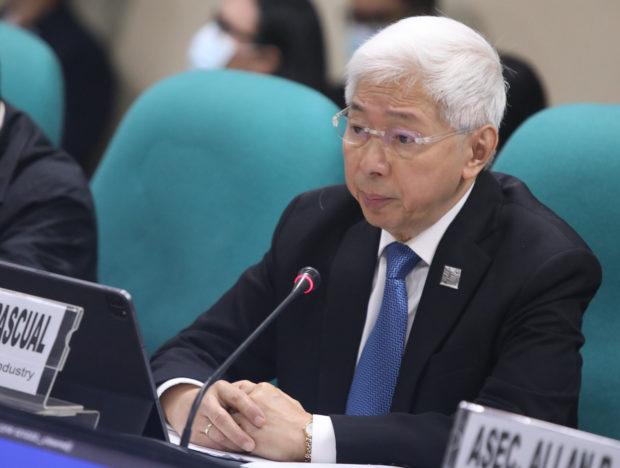
Department of Trade and Industry (DTI) Sec. Alfredo Pascual attends the Committee on Foreign Relations’ public hearing in this file photo taken on December 12, 2022. Senate PRIB file photo / Bibo Nueva España
MANILA, Philippines — President Ferdinand Marcos Jr. has approved the Philippine Export Development Plan, which aims to strengthen the country’s industries and position the nation as a potential exporting hub, Trade Industry Secretary Alfredo Pascual said.
Pascual confirmed during the Presidential Communications Office (PCO) briefing on Tuesday, saying that the Philippine Export Development Plan was tackled during the sectoral meeting with cabinet officials earlier at Malacañang.
“We presented to the President the proposed Philippine Export Development Plan, which [the Department of Trade and Industry] DTI formulated pursuant to the Export Development Act of 1994. As already mentioned, this defines the country’s export thrusts, strategies, programs, and projects, and we sought the President’s approval which we got with just some of couple of additions to the plan,” Pascual said.
“The PDP aims to address challenges that we face in various sectors of the economy, particularly those sectors that are involved in or potentially could be involved in exports. Our proposal is actually in line with the Philippine Development Plan, which was earlier released by the administration,” he added.
“This export development plan will capitalize on export growth opportunities considering market trends, and the available or existing competencies in the Philippines, among our industries. It seeks to undertake an industry development-centric approach to make the Philippines a major player in the global economy and achieve sustainable development goals,” he added.
Pascual admitted that the Philippine Export Development Plan would be key to improving the country’s export industry, as the Philippines currently lags in exportation compared to its Southeast Asian neighbors.
“So we must develop reliable, design-driven, technology-driven, sustainable, and forward-looking exporters to become or to make the Philippines an agile export powerhouse. As you may know, the Philippines is lagging behind our neighboring countries when it comes to export,” Pascual said.
“We can consider ourselves as laggards currently, so this plan will help us uplift the government’s or I mean the Philippines’ performance in exports. It may not be to yet, match the levels achieved by the more-progressive neighbors that we have, but it will certainly improve the volume of our exports,” he added.
While there have been recent improvements in the country’s status as an exporter, the reality is that the Philippines has been overtaken by its peers. In terms of exportation to the United States, the country could export in 2020, under the Generalized System of Preferences (GSP) framework, around $1.6 billion worth of goods.
That is behind GSP users Thailand, Indonesia, Brazil and Cambodia.
READ: PH looks to other venues to deepen US trade
In terms of innovation which is a key factor nowadays in exportation, the Philippines only ranked 59th out of 132 countries in the Global Innovation Index (GII) from 2021 to 2022.
READ: Global innovation: PH struggling to keep up with other countries
According to Pascual, the plan has three strategic actions:
- Addressing production constraints
- Developing a strong, innovative export ecosystem
- Increasing the Philippines’ mindshare in the global market
All three go together, the Department of Trade and Industry (DTI) chief said, as first, it would be important to strengthen industries so production can be increased. However, it is also equally essential for the country to have a strong ecosystem and for the local industry to be known worldwide.
“So before we can export we need to produce. So first challenge is helping industries produce products that can compete in the market — this requires input of technology, it requires raising of productivity, training of the people that they employ, et cetera,” he said.
“And then the third strategy is increasing the Philippines’ mindshare in the global market. What do we mean by this? We need to raise the awareness of our target markets about the export firms and the exportable products available in the Philippines, this will involve doing promotional efforts, like what we’ve done with the presidential visits,” he added.